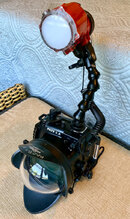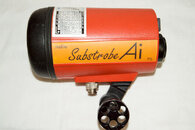Ryan Neely
Contributor
Right. So, I've been a photographer on land for nearly thirty years, but I'm poor (kind of). Perhaps it would be more accurate to say that I'm deliberate in my spending. I've been shooting Canon since then, but haven't purchased a new body or lens for over two decades. A part of that has to do with my need to spend my income on more important things (photography is no longer a profession; it is now just a hobby) and part of it has to do with the fact that the results I get with my outdated gear are more than accurate.
After earning my OW in 2019, I'm rapidly approaching my 100th dive and finally feeling confident enough in both my skills and my dive gear to feel like it's time to begin exploring the options for an underwater camera system.
I've owned several FauxPros over the past two years. We take them diving to film each other while practicing skills. We then watch the video back to see how we did and analyze places where there is room for improvement. However, these FauxPros have recently been prone to flooding (I'm sure that's my fault, but I don't know enough about housing to know how to prevent this from happening--especially with such cheap equipment that seems designed to be disposable . . . it isn't like I can just pick up some new gaskets from somewhere).
My original intent for an underwater rig was to seek out a dSLR or (more likely) a mirrorless body, a macro lens, and a housing. Mostly, I feel this way because I'm so used to having total control over my settings (shutter, aperture, white balance) that the idea of using a GoPro as my primary rig seems . . . blasphemous? . . . limiting at the very least. (I know several folks who produce great video with a GoPro, but I'm looking for stills, that's my shtick.)
However, my wife recently pointed out the additional maintenance and care that will be required to prevent any "big camera" from being flooded inside a housing and suggested that maybe I start by looking into finding a rig that is entirely sealed.
The only setup I know like this is the SeaLife Micro 3.0 which seems . . . fine? . . . adequate. It really seems like a step up from a point-and-shoot but not quite as customizable as a dSLR.
What other options are out there? What does everyone recommend? (I mean, I realize asking that question here is like asking which mask is best or which set of fins are best, but hearing other peoples' perspectives is often quite helpful--especially if they include detailed and thoughtful analyses.)
I imagine the first question that will be asked is: What am I looking for in a rig?
Well, ideally, I'd like something with a larger sensor. Something that will allow me to control aperture and shutter speed as necessary. Something that shoots in RAW (or, something that will allow me to set a custom white balance easily if I'm forced to shoot in JPEG). I'm on the fence about strobes. Using them appropriately (especially in conjunction with being able to modify shutter speed and aperture settings) would allow for the production of some unique imagery, but I'm also concerned about the effect strobes have on wildlife in general.
I'll be shooting in warm, blue, salty water during vacations, but I primarily dive in cold, green, fresh water most of the year.
Right now I seem more drawn to macro photography than to wide-angle photography (especially given the cold, green, darkness of the pits we dive in throughout the year).
Someone on another thread mentioned the Olympus TG-6, which seems like an okay camera but requires a housing below fifty feet, and I'm just leery about my ability to properly maintain a housing right now. Maybe I'm lazy, or maybe this is a fear of the unknown, or maybe it's my cats' fur that is getting everywhere.
If I'm honest, I'm a bit hesitant to spend the money on something more expensive given the knowledge that a flood will occur, it's just a matter of when. I'd hate to destroy a mirrorless body and (especially) a lens.
Anyway, thoughts? Ideas? Opinions? Bring it on, folks. Let's hear it all.
After earning my OW in 2019, I'm rapidly approaching my 100th dive and finally feeling confident enough in both my skills and my dive gear to feel like it's time to begin exploring the options for an underwater camera system.
I've owned several FauxPros over the past two years. We take them diving to film each other while practicing skills. We then watch the video back to see how we did and analyze places where there is room for improvement. However, these FauxPros have recently been prone to flooding (I'm sure that's my fault, but I don't know enough about housing to know how to prevent this from happening--especially with such cheap equipment that seems designed to be disposable . . . it isn't like I can just pick up some new gaskets from somewhere).
My original intent for an underwater rig was to seek out a dSLR or (more likely) a mirrorless body, a macro lens, and a housing. Mostly, I feel this way because I'm so used to having total control over my settings (shutter, aperture, white balance) that the idea of using a GoPro as my primary rig seems . . . blasphemous? . . . limiting at the very least. (I know several folks who produce great video with a GoPro, but I'm looking for stills, that's my shtick.)
However, my wife recently pointed out the additional maintenance and care that will be required to prevent any "big camera" from being flooded inside a housing and suggested that maybe I start by looking into finding a rig that is entirely sealed.
The only setup I know like this is the SeaLife Micro 3.0 which seems . . . fine? . . . adequate. It really seems like a step up from a point-and-shoot but not quite as customizable as a dSLR.
What other options are out there? What does everyone recommend? (I mean, I realize asking that question here is like asking which mask is best or which set of fins are best, but hearing other peoples' perspectives is often quite helpful--especially if they include detailed and thoughtful analyses.)
I imagine the first question that will be asked is: What am I looking for in a rig?
Well, ideally, I'd like something with a larger sensor. Something that will allow me to control aperture and shutter speed as necessary. Something that shoots in RAW (or, something that will allow me to set a custom white balance easily if I'm forced to shoot in JPEG). I'm on the fence about strobes. Using them appropriately (especially in conjunction with being able to modify shutter speed and aperture settings) would allow for the production of some unique imagery, but I'm also concerned about the effect strobes have on wildlife in general.
I'll be shooting in warm, blue, salty water during vacations, but I primarily dive in cold, green, fresh water most of the year.
Right now I seem more drawn to macro photography than to wide-angle photography (especially given the cold, green, darkness of the pits we dive in throughout the year).
Someone on another thread mentioned the Olympus TG-6, which seems like an okay camera but requires a housing below fifty feet, and I'm just leery about my ability to properly maintain a housing right now. Maybe I'm lazy, or maybe this is a fear of the unknown, or maybe it's my cats' fur that is getting everywhere.
If I'm honest, I'm a bit hesitant to spend the money on something more expensive given the knowledge that a flood will occur, it's just a matter of when. I'd hate to destroy a mirrorless body and (especially) a lens.
Anyway, thoughts? Ideas? Opinions? Bring it on, folks. Let's hear it all.








